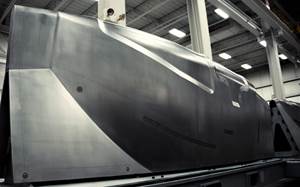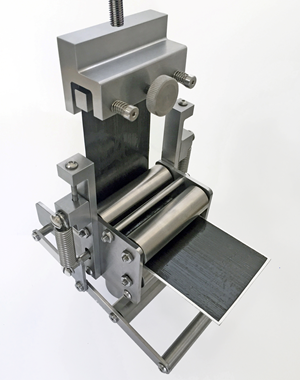Purging conservatism from composite designs
Craig Collier, president of Collier Research Group (Hampton, Va.) says cross-discipline software interconnectivity will unlock the full potential of composites.
Although the composites industry is maturing, overbuilt designs are still the rule rather than the exception. The departmental divisions between designers, analysts and manufacturing engineers — not any single person or process — are the culprits. For example, designers generally aren’t required to know if their design can carry specific loads, and stress analysts aren’t trained in the fine points of shop-floor fabrication. Also, there is no real-time design iteration among these three disciplines, just a series of data handoffs. Without good communication and an iterative product-development process, composite designs easily can be 15 to 20 percent overweight and, as a result, material cost is unnecessarily high.
In recent years, computer-aided engineering (CAE) software has evolved in parallel with composite materials and manufacturing technology. As material systems have advanced, so have the capabilities to virtually simulate and optimize designs. Finite element analysis (FEA) has grown increasingly accurate in calculating loads and predicting stresses; CAD and other composites software have ever more sophisticated means to orchestrate the manufacturing process. But departmental disconnects between computer-aided tools have prevented the industry from fully realizing the potential of composite materials.
A composite product is born in the design department. From there, the design is passed to the structural engineering group, which determines the laminate thickness and layup angles for design details, such as bolted joints, to ensure that the component can carry real-world loads. But when engineers can’t predict failure loads with high confidence, especially when using damage tolerance stress/strain allowables, weight almost always gets added at this stage.
The revised, load-adjusted design is then returned to the designers, who alter it further, based on input from manufacturing engineers. They simplify layup and fabrication by examining processes, such as how tape-laying machines will actually manufacture the part. To make the design more manufacturable, additional weight — typically a lot — is added. For example, without an optimization tool, designers often avoid the complex problem of ply interleaving or coverage patterns by simply adding continuous plies.
Further, designers and analysts are often out of sync, working independently and even making changes on different versions of the same design. If rigorous controls are implemented, they create a territorial mentality. Models, then, are owned by groups, and it often takes a favor, rather than a standard protocol, to get an update. Bookkeeping standards in terms of material properties, IDs, numbering systems, and specs, can differ between groups, contributing to a bumpy process flow.
Design-isolation problems do not end there. In companies with hundreds of engineers, getting data out of CAD or specialized composites software and into an FEA solver or pre- or postprocessor is a common engineering hurdle. The same is true of trying to import analysis data into the CAD system.
Data disconnect and design departmentalization can be addressed by building connectivity among the tools that are spread throughout the company. Composite analysis software, for example, can serve as a CAE interface and data exchange hub. By iterating in a continuous loop with FEA solvers, analysts can automate the analysis, determine required sizes and laminate specs from a stress need, using corrected stress/strain allowables, and then calculate the most manufacturable layup and optimize the design, with substantial weight savings. As a connecting hub, the software can streamline data interchange via customized and compatible interfaces with CAD (e.g., CATIA or Pro-E), finite element modelers (e.g., PATRAN or FEMAP) and composite software tools (e.g., FiberSIM or Simulayt), eliminating hours of manual calculations, offline spreadsheet development and model remeshing.
When design and analysis departments are linked for smooth data flow, designs are more easily iterated. If more manufacturing considerations are brought to the analysis and optimization stages early on, designs become more manufacturable. As CAD and FEA tools become more closely interconnected, and as specialized composite analysis is added to the mix, there will be fewer design shortcomings, negative margins of safety or inadequate safety factors. And that 15 to 20 percent weight reduction for composite structures doesn’t need to be left on the industry table. Given today’s affordability issues, this alone is huge.
Explosive growth of composites in a variety of industries is just around the corner. But around that same corner, the walls that separate design disciplines are still high. Composite-specific software tools have already opened some design doors, helped automate manufacturing and cut costs. But greater cross-discipline software interconnectivity will give companies looking for breakthroughs built on composites the ability to unlock the material’s full potential.
Related Content
Jeep all-composite roof receivers achieve steel performance at low mass
Ultrashort carbon fiber/PPA replaces steel on rooftop brackets to hold Jeep soft tops, hardtops.
Read MoreNine factors to consider when designing composites cure tooling
Gary Bond discusses the common pitfalls and compromises when designing good cure tooling and their holistic significance for a robust composite production process.
Read MoreComposite prepreg tack testing
A recently standardized prepreg tack test method has been developed for use in material selection, quality control and adjusting cure process parameters for automated layup processes.
Read MoreJEC World 2022, Part 3: Emphasizing emerging markets, thermoplastics and carbon fiber
CW editor-in-chief Jeff Sloan identifies companies exhibiting at JEC World 2022 that are advancing both materials and technologies for the growing AAM, hydrogen, automotive and sustainability markets.
Read MoreRead Next
From the CW Archives: The tale of the thermoplastic cryotank
In 2006, guest columnist Bob Hartunian related the story of his efforts two decades prior, while at McDonnell Douglas, to develop a thermoplastic composite crytank for hydrogen storage. He learned a lot of lessons.
Read MoreCW’s 2024 Top Shops survey offers new approach to benchmarking
Respondents that complete the survey by April 30, 2024, have the chance to be recognized as an honoree.
Read MoreComposites end markets: Energy (2024)
Composites are used widely in oil/gas, wind and other renewable energy applications. Despite market challenges, growth potential and innovation for composites continue.
Read More












.jpg;maxWidth=300;quality=90)








